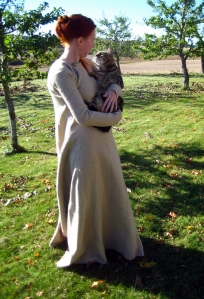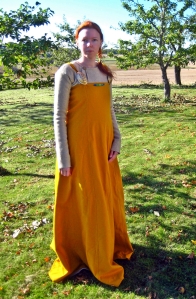Över särken kan en kirtle bäras, Hägg kallar det tunika. Bland Birkas gravar finns det 23st med fynd som skulle kunna vara just en kirtle samt ytterligare 27 med livplagg som skulle kunna vara en kirtle, men lika gärna kan vara någon annan typ av livplagg.
Over the serkr one could wear a kirtle, Hägg calls it a tunic. Among the Birka graves there are 23 with finding that could be a kritle and another 27 with garments that could be a kritle or some other type of garment.
Jag har valt att sy kirtlen i en lite tjockare fiskbenskypert. Som jag nämt tidigare är detta lite kontroversielt, det finns exempel men de är försvinnande få jämfört med diamantkyperten och den vanliga kyperten. I återskapade sammanhang finns det däremot fiskbenskypert i överflöd. Hade jag köpt nytt tyg hade jag valt en tunn vanlig kypert men nu valde jag att använda mig av tyg jag redan hade hemma. Efter att ha läst Ewings teorier om kilarnas placering (där han hävdar att det inte är vanligt med kilar i plaggen och att Hedeby är ett undantag eftersom det ligger nära kontinenten) har jag valt att bara sy kilar i sidsömmarna. Det passar mig eftersom jag är måttligt förtjust i att sy i kilar i hela fram- eller bakstycken. Halslinningen sluter tätt intill halsen, precis som på serkrn, men har sprundet placerat assymetriskt och inte mitt fram, för att slippa drag genom både kirtle och serkrns sprund, ett assymetriskt placerat sprunt kan ses på plagg från grav bj 964 och bj965. Det är fäst med samma broch som jag använt till serkrn. Plagget är handsytt med förstygn och ylletråd.
I have choosen to make the kirtle out of a herringbone twill. As I have mention before this is a bit controversial, there are examples but they are few when you look at all the diamond twill and regular twill. In the re-enacted world on the other hand herringbone twill can be found everywhere you look. Had I bought new fabric for the project I would have chosen a regular twill but now I choose to work with the fabric I already had at home. After I’ve read the theories by Ewing about the placement of the gores (he claims that gores are not that common and that the Hedeby finds are an exception because of Hedebys placement close to the continent) I have chosen to sew gores only into the side seams. That suites me well since I am not found of sewing gores into whole front- or back pieces. The neckline is close to the neck, as in the serkr, but the placket placement is asymmetrical to avoid draft into the skin, the placement can be seen on garments from grave bj964 and bj965. The placket is closed with the same brooch that I used on the serkr. The garment is sewn by hand with a wool thread.
Literature:
Inga Hägg, Kvinnodräkten i Birka, Aun 2 Uppsala (1974)
Thor Ewing, Viking clothing, History press (2007)


